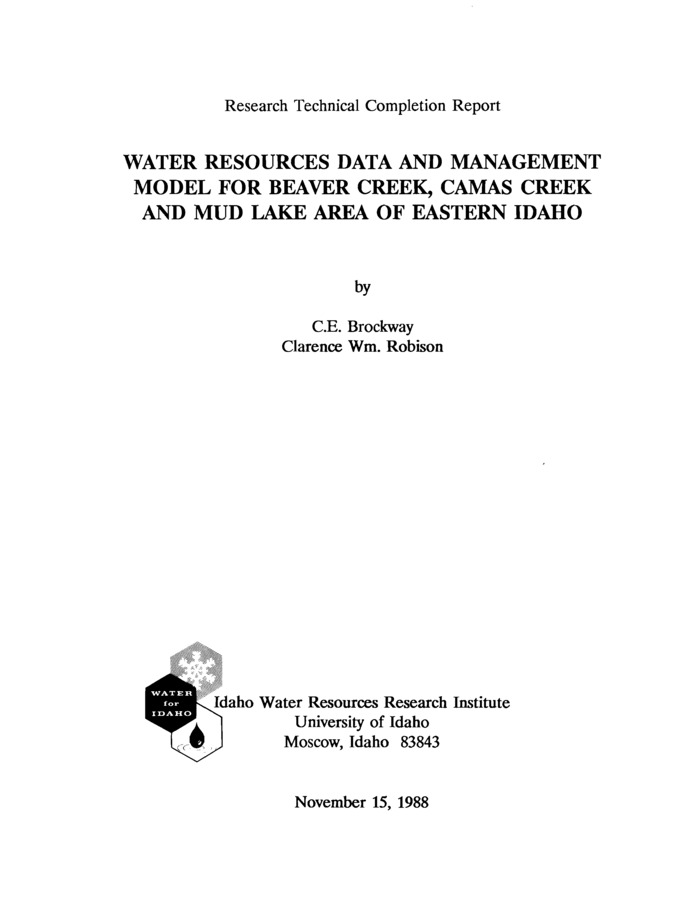PDF
Water resources data and management model for Beaver Creek, Camas Creek and Mud Lake area of eastern Idaho. Research technical completion report Item Info
- Title:
- Water resources data and management model for Beaver Creek, Camas Creek and Mud Lake area of eastern Idaho. Research technical completion report
- Authors:
- Brockway, C. E.; Robison, Clarence Wm.
- Contributors:
- Idaho Water Resources Research Institute; IWRRI
- Date:
- 1988-11-15
- Description:
- Mud Lake, a natural closed basin in eastern Idaho, is used as a reservoir for storage of irrigation water. Mud Lake has been modified by the construction of dikes and levies to provide storage of approximately 64,200 acre feet. The water supply is furnished by surface runoff from Beaver Creek and Camas Creek and by artesian and pumped wells from the Snake Plain Aquifer. Beaver Creek, with a drainage area of approximately 510 square miles is tributary to Camas Creek at a point near Camas, Idaho, and normally dries up in late spring. There are irrigation diversions on Beaver Creek above Camas Creek serving approximately 5,800 acres. The topography of the Beaver Creek drainage confines the stream except for the lower reach just above Camas. Camas Creek originates in the Beaverhead mountains and irrigates approximately 8,100 acres above Camas. Major tributaries are West Camas, East Camas, and Beaver Creeks. A dam was constructed on Camas Creek near Lone Tree but is not currently functioning. The diversion structure at Lone Tree is capable of diverting approximately 1000 cfs into the basalt and lava flows east of Camas Creek. This diversion has been used in the past to divert flood flows from Camas Creek which then sink into the fractured basalt. Another main diversion from Camas Creek is the Warm Creek channel through which up to 200 cfs can be diverted in the NE 1/4 SW 1/4 Sec 28 T 8N R 36E. Flows in Warm Creek fill depressions and ponds in the upper areas of the wildlife refuge, with the remainder returning to the Camas Creek channel. Camas Creek drains an area of approximately 1130 square miles above Mud Lake and flows through the Camas Wildlife Refuge into Mud Lake through a regulating structure called the Bybee gates or Bybee structure. The gates at the Bybee structure can be closed to retain Camas Creek discharge in the refuge area or opened to fill Mud Lake. Rays Lake, within the Camas Wildlife Refuge, is served by Camas Creek and also serves as a reservoir for irrigation pumping for lands to the south of Camas Creek. Also within the Camas Wildlife Refuge are numerous artesian and pumped wells which are used by the Federal Fish and Wildlife Service to maintain water levels in the surface ponds. Artesian flow from wells is collected in ditches and transported to Mud Lake during both the winter and irrigation periods. These wells are generally shallow wells penetrating the basalts of the Snake Plain Aquifer which is partially confined in the area just north and east of Mud Lake. The primary groups of users which utilize well water are the Independent Water Users, the Owsley Canal, and the Holly Water Users. Normally, these wells flow under artesian conditions in the winter and spring and are pumped after the irrigation season begins; however, the wells are pumped during late winter and spring during low water years. During years when flood conditions are imminent, these wells can be, and have been, capped to reduce inflow into Mud Lake. Mud Lake and the watersheds of Beaver Creek and Camas Creek are administered by Water District 66. The watermaster for this district is Mr. Don Shenton, who has held that position since 1960. During the irrigation season, the watermaster allocates water according to a federal decree which includes all water users. Because of the relationships between surface water and groundwater systems and the complicated operation of artesian well systems, evaluation of the effects of changes in surface flows or utilization of wells on Mud Lake is not possible without a computer based water balance model. In order to evaluate the efficiency and/or impacts of possible flood control measures on Mud Lake, a simplified water balance model of the system was developed.
- Subjects:
- water resources data water management model studies water balance model artesian aquifers pumped storage irrigation water allocation hydrology computer models mathematical models
- Location:
- Beaver Creek; Camas Creek; Mud Lake; Warm Creek; Eastern Idaho
- Idaho County:
- Jefferson County
- Latitude:
- 43.906894
- Longitude:
- -112.384987
- Collection:
- IWRRI
- Series:
- Water for Idaho
- Source:
- Idaho Water Resources Research Institute, University of Idaho
- Identifier:
- IWRRI Number 198802
- Publisher:
- Idaho Water Resources Research Institute, University of Idaho
- Contributing Institution:
- University of Idaho
- Type:
- Text
- Format:
- application/pdf
- Cataloger:
- jh
- Date Digitized:
- 2015-02-26
- Language:
- eng
Source
- Preferred Citation:
- "Water resources data and management model for Beaver Creek, Camas Creek and Mud Lake area of eastern Idaho. Research technical completion report", Idaho Waters Digital Library, University of Idaho Library Digital Collections, https://www.lib.uidaho.edu/digital/iwdl/items/iwdl-198802.html
Rights
- Rights:
- In copyright, educational use permitted. Educational use includes non-commercial reproduction of text and images in materials for teaching and research purposes. For other contexts beyond fair use, including digital reproduction, please contact the University of Idaho Library Special Collections and Archives Department at libspec@uidaho.edu. The University of Idaho Library is not liable for any violations of the law by users.
- Standardized Rights:
- http://rightsstatements.org/vocab/InC-EDU/1.0/

